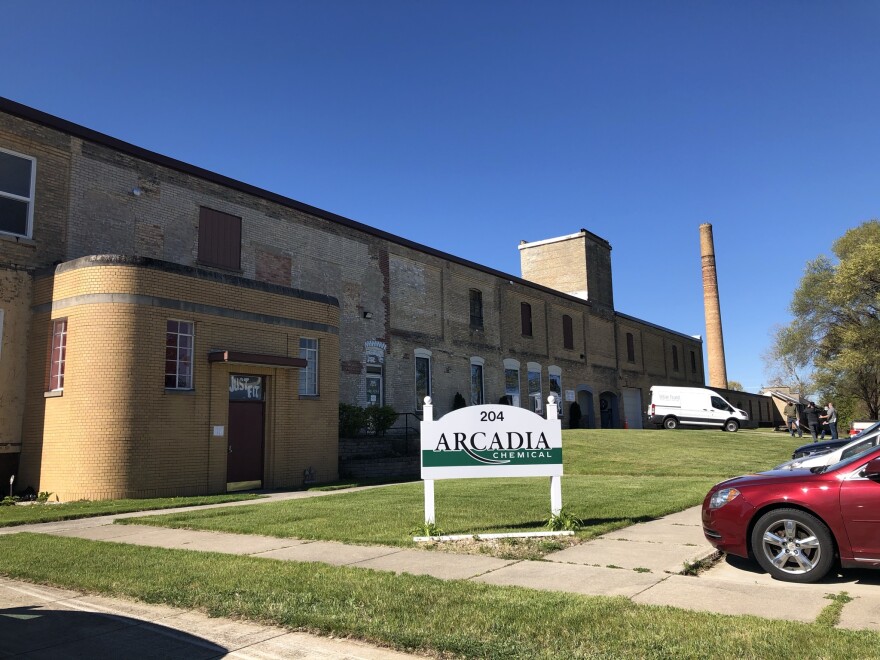Sam Ewbank of Bloomingdale, a remodeler by trade, says that as he worked on a job in Lawton earlier this year, he “just kept noticing the chimney and that it stood there by itself.”
The smokestack is at the far end of the building. As we speak, Sam and I are standing at the other end, in the parking lot near the front door. Sam is right – the chimney is very close to the building but not quite attached.
“It seemed like there should be some sort of history to it,” he said.
As Sam and I discovered, its origins lie in a venerable local industry. We got the details as we toured the property one morning last May with two guides. The first is Lawton Public Museum Director Rodney Reid. As a kid, Reid lived across from the building in the late 1960s and early ‘70s.

“At that time the place was basically vacant,” he said.
And Dan DeBoer, who owns the building and runs a small chemical manufacturing business there. You can see the chimney coming into town, and DeBoer says when his kids were little, “The first thing they would say when we crested the hill on M-40 was ‘that’s where Daddy works.’”

Before we dive into the history, we walk over to the chimney to get a closer look, strolling around the imposing base. From a distance the smokestack looks yellow, but up close the bricks resolve into a range of colors – pale lemon-yellow, red, brown.
Dan DeBoer looks toward the sky.
“If you stand at the base,” he says, “and look straight up when there’s clouds moving by,” you get a trippy effect – a “real strange feeling that something’s moving.”
Who built the chimney?
In its early days this building was heated with coal. The chimney’s role was simply to vent smoke from the coal-fired boiler. So, although it looks freestanding, when it was in use the chimney would have connected to the building. Perhaps at the big square opening in the chimney’s building side. Peering through this opening, DeBoer notes the iron rungs ascending the smokestack’s inner wall.

“I’ve never found anyone brave enough that wants to go up there but I’ve offered it to many people,” he tells Reid.
“I do, but not today, but I do,” Reid says.
But who built the chimney and what was the building for?
It turns out we can thank grapes. Viticulture has been part of Lawton’s economy since just after the Civil War. Reid says a handful of settlers discovered grapevines thrived in the local climate and soil.
“It just kind of really took off and they found success with that, and next thing you know, there’s just grapes all over Southwest Michigan. But really, it kind of started right here in Lawton,” he said.

With grape-growing came a parallel industry – processing those grapes into juice, right in downtown Lawton. By 1908 a small juice plant stood on the site. Four years later a company called J. Hungerford Smith bought the building, expanded it, and built the iconic smokestack. But the chimney’s been out of use for most of its hundred-plus years. The juice plant was idle by the mid-1930s. And it’s not clear the smokestack was ever used again. But the rest of the building came back to life during World War II, when the Eaton Manufacturing Company used it as factory for engine parts.
The Eaton years
To learn more about Eaton’s legacy, we head inside to DeBoer’s office, where he shows us what looks like a metal, palm-sized candlestick.
“This is an engine valve that we found during excavation. We don’t know what it’s to or from, but it’s presumably what they made here,” he explains.

Reid concurs, adding that Eaton first made airplane valves at the plant, for the war effort. In the 1950s, it broadened its product line. “For automobiles and also trucks, and even tanks they made valves for here,” he says.
But Eaton, too, was gone by the time Reid’s family moved across the street at the end of the 1960s. As Reid mentioned, at that time the building was more or less empty.

Eventually it was reborn as a commercial and creative space, hosting, over the years, a pizza parlor, a printmaking studio and more. Current businesses besides DeBoer’s include a tax service and a salon.

But it was the building’s old brick chimney that caught Sam Ewbank’s eye. It’s reportedly in excellent condition.
“Hopefully it’ll last another hundred years,” Sam says.
Sam's friend PJ Chmiel of Lawton photographed the Eaton building, chimney and grounds during the tour. See the entire photo album here.






